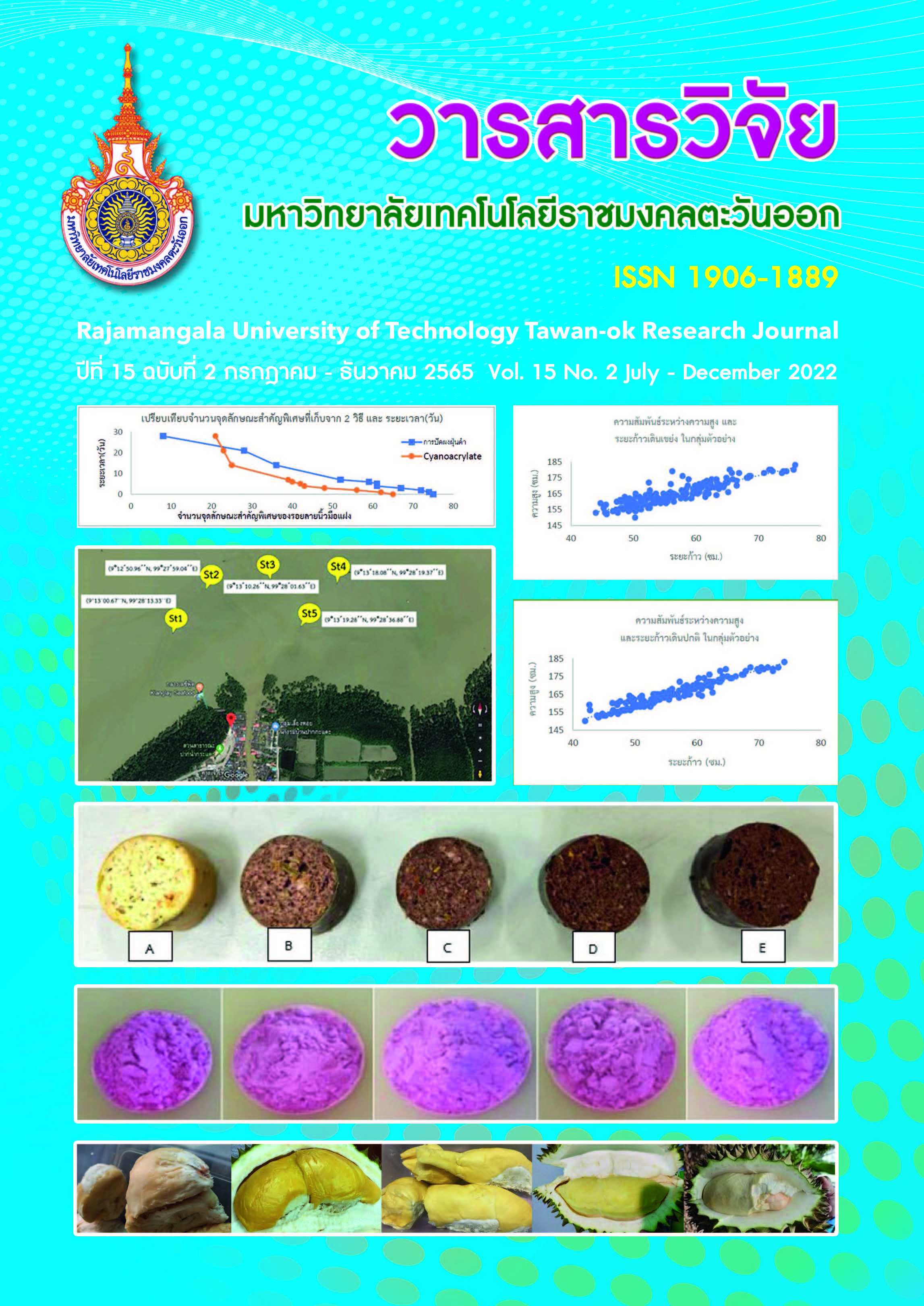ทุเรียน : ราชาแห่งผลไม้กับคุณประโยชน์ด้านสุขภาพ
Main Article Content
บทคัดย่อ
ทุเรียนได้ชื่อว่าเป็นราชาแห่งผลไม้เขตร้อน เป็นพืชเศรษฐกิจที่มูลค่าการส่งออกลำดับต้นๆของประเทศไทยโดยเฉพาะภาคตะวันออก นอกจากจะมีรสชาติอร่อยแล้ว ยังมีคุณประโยชน์ด้านสุขภาพมากมาย อุดมไปด้วยสารต้านอนุมูลอิสระ วิตามินและแร่ธาตุ รวมทั้งกรดไขมันจำเป็นหลายชนิด ซึ่งมีส่วนช่วยในเรื่องสุขภาพ ลดอัตราการเกิดโรคเรื้อรังต่างๆ แต่การศึกษาส่วนใหญ่จะทำในหลอดทดลองมากกว่าในสัตว์ทดลองหรือในมนุษย์ และแม้ว่าทุเรียนจะมีประโยชน์ต่อสุขภาพหลายประการ แต่เนื่องจากเป็นผลไม้ให้พลังงานและมีคาร์โบไฮเดรตสูง จึงควรบริโภคแต่พอดีจะให้ประโยชน์มากกว่าโทษ
Article Details

อนุญาตภายใต้เงื่อนไข Creative Commons Attribution-NonCommercial-NoDerivatives 4.0 International License.
เอกสารอ้างอิง
Arancibia-Avila, P., F. Toledo, P. Yong-Seo, J. Soon-Teck, K. Seong-Gook, H. Buk-Gu, L. Sang-Hyun, M.Sajewicz, T.
Kowalska and S. Gorinstein. 2008. Antioxidant properties of durian fruit as influenced by ripening. LWT - Food
Science and Technology. 41 : 2118 - 2125.
Chansiripornchai, N., P. Chansiripornchai and S. Pongsamart. 2008. A preliminary study of polysaccharide gel
extracted from the fruit hulls of durian (Durio zibethinus) on immune responses and cholesterol reduction in
chicken. Acta Horticulturae. 786 : 57 - 60.
Charoenkiatkul, S., P. Thiyajai and K. Judprasong. 2016. Nutrients and bioactive compounds in popular and
indigenous durian (Durio zibethinus murr.). Food Chemistry. 193 : 181 - 186.
Gorinstein, S., R. Haruenkit, S. Poovarodom, S. Vearasilp, P. Ruamsuke, J. Namiesnik, M. Leontowicz, H.Leontowicz, M.
Suhaj and G.P. Sheng. 2010. Some analytical assays for the determination of bioactivity of exotic fruits.Phytochemical Analysis. 21 : 355 - 362.
Gorinstein S., S. Poovarodom, H. Kruszewska, M. Leontowicz, N. Jacek, V. Suchada, R. Haruenkit, P.Ruamsuke, K. Elena
and T. Zev. 2011. Antioxidant properties and bioactive constituents of some rare exotic Thai fruits and comparison with conventional fruits: in vitro and in vivo studies. Food Research International. 44 (7) : 2222 - 2232.
Haruenkit, R., S. Poovarodom, S. Vearasilpm, J. Namiesnik, M. Sliwka-Kaszynska, Y.S. Park, B.G. Heo, J.Y.Cho, H.G. Jang
and S. Gorinstein. 2010. Comparison of bioactive compounds, antioxidantand antiproliferative activities of Mon
Thong durian during ripening. Food Chemistry.118 : 540 - 547.
Leontowicz H., M. Leontowicz, I. Jesion, W. Bielecki, S. Poovarodom, S. Vearasilp, G. González-Aguilar, M. Robles-
Sánchez, S. Trakhtenberg, S. Gorinstein. 2011. Positive effects of durian fruit at different stages of ripening on the hearts and livers of rats fed diets high in cholesterol. European Journal of Integrative Medicine. 3 : e169 - e181.
Leontowicz, H., M. Leontowicz, R. Haruenkit, S. Poovarodom, Z. Jastrzebski, J. Drzewiecki, A.L. Ayala, I. Jesion, S.
Trakhtenberg and S. Gorinstein. 2008. Durian (Durio zibethinus Murr.) cultivars as nutritional supplementation to rats diets. Food and Chemical Toxicology. 46 : 581 - 589.
Office of Agricultural Economics. 2021. Agricultural Economic and Agricultural Production Information of Durian.
Ministry of Agriculture and Cooperatives. https://www.oae.go.th/assets/portals/1/fileups/prcaidata/files/durian63.pdf. Accessed 31 Aug. 2021. (in Thai)
Rai, P.K, Mehta, S. and Watal, G. 2010. Hypolipidaemic and hepatoprotective effects of Psidium guajava raw fruit peel
in experimental diabetes. Indian J. Med Res. 131: 820-824.
Robert, D., Ismail, A.A., Winn, T., and Wolever, T.M.S. 2008. Glycemic index of common Malaysian fruits. Asia Pac. J.
Clin. Nutr. 17: 35-39.
Srimoon, R. 2021. Durian at Different Stages of Ripening Preferable survey. Rajamangala University of Technology
Tawan-Ok, Chanthaburi Campus, Chanthaburi. (in Thai)
Toledo, F., Arancibia-Avila, P., Park, Y.S., Jung, S.T., Kang, S.G., Heo, B.G., Drzewiecki, J., Zachwieja., Z., Zagrodzki, P.,
Pasko, P. and Gorinstein, S. 2008. Screening of the antioxidant and nutritional properties, phenolic contents and proteins of five durian cultivars. Int. J. Food Sci. Nutr. 59: 415-427.


